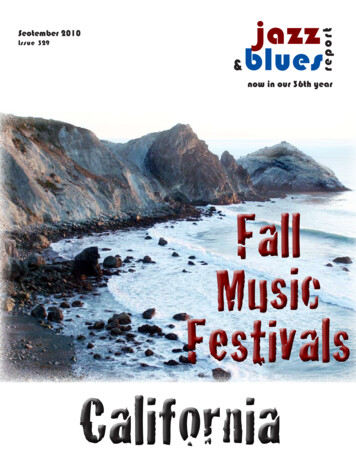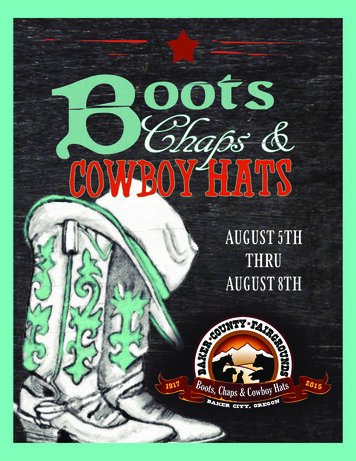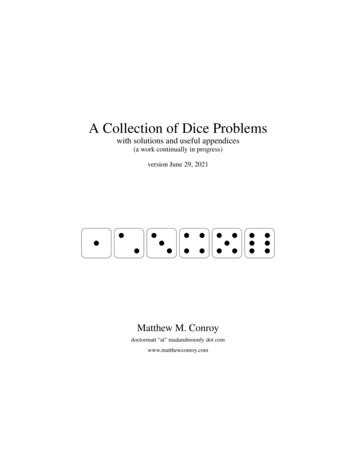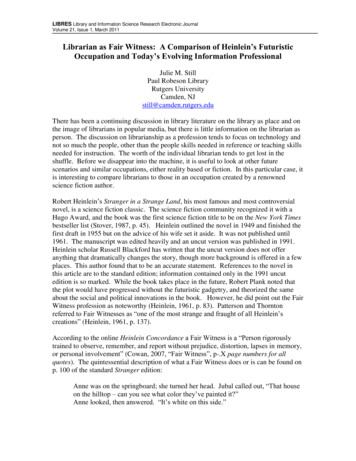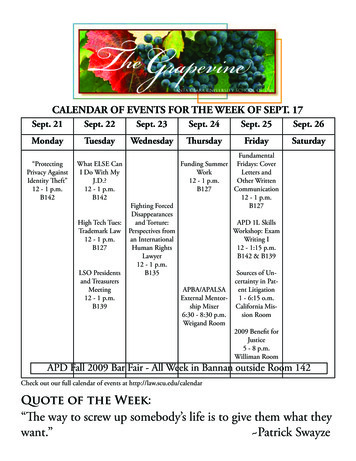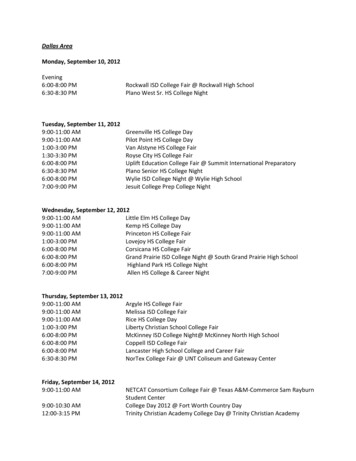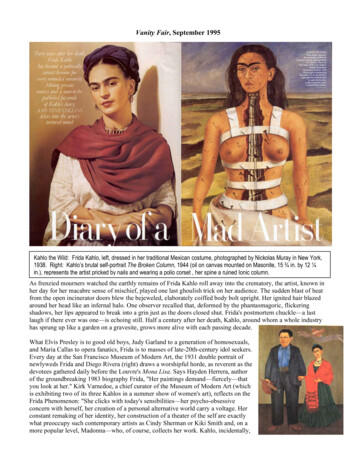
Transcription
Vanity Fair, September 1995Kahlo the Wild: Frida Kahlo, left, dressed in her traditional Mexican costume, photographed by Nickolas Muray in New York,1938. Right: Kahlo’s brutal self-portrait The Broken Column, 1944 (oil on canvas mounted on Masonite, 15 ¾ in. by 12 ¼in.), represents the artist pricked by nails and wearing a polio corset , her spine a ruined Ionic column.As frenzied mourners watched the earthly remains of Frida Kahlo roll away into the crematory, the artist, known inher day for her macabre sense of mischief, played one last ghoulish trick on her audience. The sudden blast of heatfrom the open incinerator doors blew the bejeweled, elaborately coiffed body bolt upright. Her ignited hair blazedaround her head like an infernal halo. One observer recalled that, deformed by the phantasmagoric, flickeringshadows, her lips appeared to break into a grin just as the doors closed shut. Frida's postmortem chuckle—a lastlaugh if there ever was one—is echoing still. Half a century after her death, Kahlo, around whom a whole industryhas sprung up like a garden on a gravesite, grows more alive with each passing decade.What Elvis Presley is to good old boys, Judy Garland to a generation of homosexuals,and Maria Callas to opera fanatics, Frida is to masses of late-20th-century idol seekers.Every day at the San Francisco Museum of Modern Art, the 1931 double portrait ofnewlyweds Frida and Diego Rivera (right) draws a worshipful horde, as reverent as thedevotees gathered daily before the Louvre's Mona Lisa. Says Hayden Herrera, authorof the groundbreaking 1983 biography Frida, "Her paintings demand—fiercely—thatyou look at her." Kirk Varnedoe, a chief curator of the Museum of Modern Art (whichis exhibiting two of its three Kahlos in a summer show of women's art), reflects on theFrida Phenomenon: "She clicks with today's sensibilities—her psycho-obsessiveconcern with herself, her creation of a personal alternative world carry a voltage. Herconstant remaking of her identity, her construction of a theater of the self are exactlywhat preoccupy such contemporary artists as Cindy Sherman or Kiki Smith and, on amore popular level, Madonna—who, of course, collects her work. Kahlo, incidentally,
is more a figure for the age of Madonna than the era of Marilyn Monroe. She fits well with the odd, androgynoushormonal chemistry of our particular epoch."In fact, a whole cross section of marginalized groups—lesbians, gays, feminists, the handicapped, Chicanos,Communists (she professed Trotskyism and, later, Stalinism), hypochondriacs, substance abusers, and even Jews(despite her indigenous Mexican identity, she was in fact half Jewish and only one-quarter Indian)—havediscovered in her a politically correct heroine. The most concrete measure of Frida's nail-digging grip on thepopular imagination is the number of publications on her: 87 and counting. (Though she has also been the subjectof at least three documentaries and one Mexican art film, the world still awaits the movies promised by Madonnaand Luis "La Bamba" Valdez.) Says art dealer Mary-Anne Martin, who as founder of Sotheby's Latin-Americandepartment presided over the first auction of a Kahlo painting, in 1977 (it went for 19,000— 1,000 below the lowestimate), "Frida has been carved up into little pieces. Everyone pulls out that one piece that means somethingspecial to them."Just when Frida fever seemed on the verge of cooling down, the public's attentionhas once again been riveted by her—1995 is turning out to be yet another annusmirabilis in the Frida chronicles. This May her 1942 Self-Portrait with Monkey andParrot (right, acquired in 1947, reports Kahlo expert Dr. Salomon Grimberg, byIBM from the Galeria de Arte Mexicano for around 400) sold at Sotheby's for 3.2 million. This is the highest price ever paid for a Latin-American work of art,and the second-highest amount for a woman artist (Mary Cassatt holds the record).About the auction record he set, Argentinean collector and venture capitalistEduardo Costantini states firmly, "There is a correlation between the painting'sprice and its quality."And riding the wave of what Sotheby's directorof Latin-American painting, August Uribe, calls "a thrilling, historical sale," nextmonth Abrams is releasing with great fanfare what may be the publishing coup ofthe season: a facsimile edition of Frida Kahlo's diary, an intimate, enigmaticwritten and pictorial record of the last and most lurid decade of the artist'stortured life. Though this document has been on display at the Frida KahloMuseum in Coyoacan, Mexico (formerly her house), since it opened in 1958,only a handful of researchers, such as Hayden Herrera, have been permitted topage through it. And even then it has resisted coherent interpretation. Thesituation has been further complicated by the fact that an executor of Kahlo'sestate, wealthy Rivera patron Dolores Olmedo, has jealously guarded the diary. Ittook the savvy young Mexican art promoter Claudia Madrazo two years topersuade Olmedo to allow publication, in order at last to make the strangeworkings of Frida Kahlo's mind, quite literally, an open book.On one page of Kahlo’s diary, anaughty French postcardpartially obscures the words onthe right—“mara villa,” a privatepun on Frida’s Spanish lover’spet name for her. The wordssonrisa (“smile”) and ternura(“tenderness”) reflect herhappiness with theirrelationship.Once she had Olmedo's blessing, Madrazo showed up at the office of New Yorkliterary agent Gloria Loomis with a fuzzy color photocopy of the diary. "1flipped," says Loomis. "It was original, moving. And I told her, yes, Americanpublishers will be crazy about it." The New York Times broke the story of thediary, announcing on its publishing page that an auction would be held that week."The next morning the phones went mad," Loomis recounts.The Mexican press had picked up the Times story, and a furor erupted. In Mexico,where Kahlo is known as la heroina del dolor, "the heroine of pain," the artistis—like the Virgin of Guadalupe—a national idol. "They were demanding toknow who is this gringa who has the right to do this to our national treasure,"Loomis says. "I had to reassure the Mexicans that I was auctioning the right toreproduce the diary in facsimile, not the diary itself." Loomis invited a series ofpublishing houses to view the color photocopy in the Banco de Mexico's New York offices and place their bids. "Iwas immediately intrigued," says Abrams editor in chief Paul Gottlieb. "I dug in my heels and went for the moon—and we won!" Though Gottlieb won't divulge the amount of his successful bid, he allows that it is more than the
100,000 estimated by an insider in the Times article but "less than 500,000."Even before the first book is sold (the initial print run is more than 150,000)Abrams undoubtedly will have made good on its investment, for Frida-mania hasa global reach. Abrams has already sold the foreign rights in nine differentcountries, and these editions will all be published simultaneously with theAmerican one. "A miracle," Gottlieb declares breathlessly. Madrazo will publishthe diary in Mexico under her own imprint—and her plans for Frida objets basedon the diary are currently under way.What is so compelling about Frida's esoteric scribblings and doodles, which areunintelligible to the casual reader (especially one with no Spanish) and, at best,puzzling to most Kahlo experts? "They're hypnotic," says art historian Sarah M.Lowe—who, in her succinct notes to the text, has valiantly endeavored to makesense of Kahlo's wild, sometimes polymorphously erotic pictographs and streamDiego Rivera and Frida Kahlo inof-consciousness ravings. (Carlos Fuentes is the author of the belletristicNew York City, 1933introduction.) "The diary is the most important work Kahlo ever did," ClaudiaMadrazo asserts. "It contains energy, poetry, magic. They reveal a moreuniversal Frida." Continues Sarah Lowe, who cautions that her comments on the diary are not definitive, "InKahlo's paintings you see only the mask. In the diary you see her unmasked. She pulls you into her world. And it's amad universe."Most pertinent to the diaries is an understanding of how the daughter of a lower-middle-class German-Jewishphotographer and a hysterically Catholic Spanish-Indian mother became a celebrated painter, Communist,promiscuous temptress, and, later (during the diary years), a narcotic-addicted, suicidal amputee afflicted with abizarre pathology known as Munchausen syndrome—the compulsion to be hospitalized and, in extreme cases,mutilated unnecessarily by surgery.DEAR DIARY A Spread from Kahlo’s enigmatic diary. Above, aportrait of “Neferisis,” who is pregnant, and her consort is, says Dr.Grimberg, the artist’s interpretation of the Egyptian gods Isis andOsiris. The first line of the text, “Strange couple from the land of thedot and line,” probably refers to her and Diego. Right, the portrait of“Neferunico” (Neferisis’s son), with his unibrow and facial hair,resembles Kahlo’s self-portraits.
Thanks to an astonishing, largely unpublished body of research ascomplete as Hayden Herrera's exhaustive biography andcomplementary to it, compiled by an unlikely scholar—Dr. SalomonGrimberg, a 47-year-old Dallas child psychiatrist—it is possible toamplify these facts of Kahlo's life and even, Grimberg says, decode90 percent of the diary." Like Kahlo, Grimberg grew up in MexicoCity, where he commenced, while still an adolescent, his rigorousinvestigations on the artist. A somewhat casual interest became anearnest fixation during his pre-med studies, when he started workingat Kahlo's former gallery, the Galeria de Arte Mexicano. There hestarted amassing records about every work of art she ever created,tracking down lost paintings, collecting pictures by her and otherartists, and befriending anyone whose life had intersected Kahlo's.Though Grimberg is something of a pariah in the art world, where hisunapologetic zeal and his affiliation with another profession are eyedPhotographer Nickolas Muray, Rivera, Vanitywith suspicion—"I am a bastard of art history," he admits—hisFair caricaturist Miguel Covarrubias, andknowledge of his subject is unrivaled and incontrovertible. He isKahlo at Rivera’s San Angel home in 1938.routinely consulted by auction houses and dealers, often withoutcompensation, who rely on him to locate, document, and authenticate art by Kahlo and others. And he has beengiven (again, without remuneration) the texts of other, better-known scholars' books for fact checking. He is,however, a paid consultant to Christie's, a curator of museum exhibitions, the author of numerous pioneeringscholarly articles, as well as a co-author of the catalogue raisonne of Kahlo's work.Because he has earned the complete confidence of several key players in the Frida story, Grimberg has beenentrusted with some startling Kahlo documents—in particular a soul-baring clinical interview conducted over manysessions between 1949 and 1950 by a Mexican psychology student named Olga Campos (a classmate of DiegoRivera's daughter by Lupe Marin). Additionally, Grimberg has the transcripts of a full battery of psychological testsKahlo underwent, in preparation for a book Campos planned to publish on the theory of creativity. Kahlo was,Campos writes, "cooperative" with her, not only because of their friendship but also because the youngpsychologist had begun her research at a devastating juncture in Frida's life. In response to a sudden announcementby Diego Rivera that he wanted a divorce to marry the Mexican film siren Maria Felix, Kahlo, Campos reports,overdosed.The text of Campos's interview—in which Frida candidly discusses her life and her paintings—forms the core ofGrimberg's unpublished book manuscript. Kahlo's intimate revelations are then fleshed out by Grimberg'spsychobiographical account of Kahlo's life, Campos's personal reminiscences about the artist, the results of theartist's Rorschach, Bleuler-Jung, Szondi, and TAT psychological tests, Kahlo's medical records, and Grimberg'sline-by-line analysis of the 170-page diary. For many years and from several sources he has been accumulatingphotographs of the journal pages (some barely the size of a playing card), assembling them in sequence, andstudying the results nightly for hours at home after work. His reading of the diary, as outlined in his unpublishedbook, is a much closer, more thorough, and more accurate interpretation than the one offered by the Abramsvolume. More astonishing still, his compilation of the diary pages is probably more complete than the Abramsfacsimile. Grimberg has discovered three missing pages that Frida had torn from the diary and given to friends—lost leaves represented in the Abrams book only as jagged, ripped edges.Though she gave her birth date as July 7, 1910, Frida Kahlo was actually born on July 6, 1907, in Coyoacan,Mexico, now a suburb of Mexico City. This most basic lie alone qualifies her for a name she goes by in the diary:"the Ancient Concealer." Her epileptic father, Guillermo Kahlo, and her mother, Matilde, had another daughter,Cristina, 11 months later. Before Frida arrived, Matilde had had a son who died a few days after birth. Unable, ortoo ambivalent, to breast-feed her, Matilde passed Frida on to two Indian wet nurses (the first, Frida told Campos,was fired for drinking). Probably because of the confusion of having three erratic caregivers, and her mother'sgeneral depression over the loss of a son (Frida called her family's household "sad"), Kahlo had from earliestinfancy a very damaged sense of self.In the absence of a Kahlo boy, Frida assumed something of a son's role in the family—certainly she was her father'sfavorite, and the one who identified most with him. Frida told Campos in her clinical interview, "I am in agreement
with everything my father taught me and nothing my mothertaught me." Lucienne Bloch, a close friend of Kahlo's anddisciple of Diego Rivera's, recalls that "she loved her father verymuch, but Frida did not have these same feelings for her mother."In fact, in 1932, when Kahlo returned to Mexico from Detroitupon hearing that her mother was dying (Bloch accompanied heron the journey), she failed to visit Matilde or even view her body.The painfully obstetric work My Birth (left, now owned byMadonna), in which Frida's head emerges from the vagina of amother whose face is covered by a shroud, was most likely herpainted response to Matilde Kahlo's death.At age six or seven, Fridacontracted polio, an illness notdetected immediately by her parents. When her right leg began thinning, theKahlos attributed the withering to "a wooden log that a little boy threw at myfoot," Kahlo told Campos. She tried to hide the deformity by wrapping heratrophied leg in bandages, which she then concealed with thick woolen socks. Theyoung Frida, however, never wore a leg brace or orthopedic shoe. Herunbuttressed limp led her pelvis and spinal column to twist and deform as shegrew, according to Grimberg, who does not agree with another doctor's recentdiagnosis that she suffered from spina bifida, a congenital condition. The etiologyof her later problems with childbearing and spinal malformation, he feels, cantherefore be traced all the way back to her polio. She herself presents this idea inher painting The Broken Column (right), in which a crevice opens in her body toreveal a backbone in the form of a ruined Ionic column. Says Grimberg, "Thesteel corset she wears in this painting is a polio corset," not the kind she later usedwhen recuperating from back operations.Though her peers maliciously nicknamed her "peg leg," Frida nevertheless found somesolace in her disease. "My papa and mama began to spoil me a lot and love me more,"Kahlo told Campos. This statement, extraordinary in its pathos, provides one sorrowfulkey to the artist's psyche. For the rest of her life, Kahlo would associate pain with love(she read one Rorschach as "male genitals with fire and thorns"), and use illness toextract from others the attention she so desperately craved. Family photographs from heradolescence show she found another unusual technique to gain attention and at the sametime disguise her gimpy leg. Surrounded by primly dressed relatives, she appears nattilyturned out in the full masculine attire of a three-piece suit and tie (left). Kahlo's earlycross-dressing, of course, also reflects her ambiguous gender identity. In a poignantsection of Campos's interview entitled "My Body," Frida responded, "The mostimportant part of the body is the brain. Of my face I like the eyebrows and eyes. Asidefrom that I like nothing. My head is too small. My breasts and genitals are average. Ofthe opposite sex, I have the moustache and in general the face." (Lucienne Bloch saysFrida always carefully groomed her mustache and unibrow with a little comb.) Kahloalso intimated to Campos that her first sexual experience occurred at age 13 with hergym and anatomy teacher, a woman named Sara Zenil. Noticing Frida's stricken leg,Zenil declared the girl "too frail," pulled her out of sports, and initiated "a physical relationship" with her. WhenKahlo's mother discovered some compromising letters, she removed Frida from the school and enrolled her insteadin the National Preparatory School, where she was one of 35 girls in a student body of 2,000. Tellingly, when shehad her first period it was a male friend who took her to the school nurse. And, she recounted to Campos, when shegot home it was to her father, not her mother, that she reported the news. While Frida was attending the NationalPreparatory School, the government engaged the celebrated muralist Diego Rivera to paint the walls of itsauditorium. Frida, about 15, developed an obsessive crush on the 36-year-old, internationally famous, andprodigiously fat Michelangelo of Mexico. She declared to her school friends that her ambition was to have hischild.
Frida's affair with Diego would begin later, however, for thecourse of her life was diverted by a cruel twist of fate. In 1925,Frida, now apprenticing (and sleeping) with an artist friend ofher father's, was riding in a wooden bus with her steadyboyfriend, Alejandro Gomez Arias, when an electric trolley carcrashed into it. Frida's boyfriend told Hayden Herrera, "Thebus.burst into a thousand pieces." Trapped under the trolley,Gomez Arias sustained comparatively few injuries. But Frida,probably destabilized by her bad leg, was pierced by thetrolley's metal handrail, which entered her lower body on theleft side and exited through her vagina, tearing its left lip. Herspinal column and pelvis were each broken in three places; hercollarbone and two ribs broke as well. Her right leg, the onedeformed by polio, was shattered, fractured in 11 places, andher right foot was dislocated and crushed. Somehow, in theFrida’s sketch, done in a hospital bed, of the accidentimpact, Frida's clothes had also been yanked off, and she wasand herself in a body cast. It is now she begins to paint.left completely nude. Even more freakish, Gomez Ariasrecalled, "someone in the bus, probably a housepainter, hadbeen carrying a packet of powdered gold. This package broke, and the gold fell all over the bleeding body ofFrida." Kahlo was hospitalized for a month (her mother visited only twice), and then sent home to recuperate.During her convalescence she bombarded Gomez Arias with lovelorn letters, and took up painting. Her letters showhow intertwined her anguish over Gomez Arias's waning attentions was with her physical suffering. She created herfirst self -portrait, a gift for her lukewarm beau, as a way to force him to think of her and look at her. "If, after herpolio, Frida ever had the chance to separate the idea of love from the experience of pain, the accident destroyed thatchance," says Grimberg. Beginning a pattern that would recur with the 30-odd operations performed on her in thecourse of her beleaguered life, Frida ended her bed rest prematurely and healed poorly.Around 1927, through mutual Communist acquaintances, she remet Diego Rivera. Their affair began after sheshowed up one day while he was frescoing Mexico City's Ministry of Education building. With paintings tuckedunder her arm, she demanded that he critique her work. In 1929 they married, launching an obsessive, earthy, anddoomed union that turned them into the Liz and Dick of the international art world. Twenty-one years older, 200pounds heavier, and, at more than six feet, nearly 12 inches taller than she, Rivera was gargantuan in both scale andappetites. As irresistible as he was ugly, Rivera was described by Frida as "a boy frog standing on his hind legs"—women flung themselves at him. (Paulette Goddard was perhaps his most famous conquest.) Casual as well ascompulsive in his philandering, he compared making love to urinating and declared he could well be a lesbianbecause he loved women so much. Frida was hopelessly attracted to him (she returns to the theme constantly in herdiaries), and developed a special fondness for hishuge stomach, "drawn tight and smooth as a sphere,"she wrote, and for "the sensitivity" of his pendulous,porcine breasts. Frida altered her persona to pleaseDiego, painting works influenced by indigenousMexican art, dressing in the colorful, femininecostumes of the Tehuantepec peninsula, andarranging her long, black tresses in Indian-inspiredstyles. Frida became pregnant just before she marriedDiego, but she aborted at three months, supposedlybecause of her twisted pelvis. Her second pregnancyended in a miscarriage—though she had in fact triedto induce an abortion by ingesting quinine. The thirdpregnancy was also terminated, quite possiblybecause it was a lover's child. It is part of the Fridamyth that she could not bring a child to term, asituation which caused her much grief and whichbecame the subject of at least two important artworksby her. Yet, in spite of her congenitallyunderdeveloped ovaries, she was still able toHenry Ford Hospital, 1932
conceive. And though her pelvis had been damaged by both polio and the accident, there still remains the questionof why she never considered a cesarean delivery. Diego supposedly worried that childbearing would ruin herdelicate health, but, as Grimberg says, "even if she were physically capable of having a child, she waspsychologically unable. It would have stood in the way of her bond with Diego," whom she babied to the point offilling his tub with toys while she bathed him.Throughout the early 30s, Kahlo traveled with Diego to San Francisco, Detroit, and New York while he worked forAmerican capitalists on large commissions with leftist themes. Kahlo, meanwhile, with Rivera's proudencouragement, developed her craft, honed her engagingly sassy persona, and made important contacts in the socialand art worlds—from the Rockefellers and Louise Nevelson (with whom Diego probably had an affair) to that otheramazon of art history, Georgia O'Keeffe. Frida's friend Lucienne Bloch remembers that Frida was "very irritated bythe famous O'Keeffe" when she met her in 1933—a reaction probably provoked by competitive feelings. But Fridahabitually neutralized rivals (usually Diego's mistresses) with a disarming camaraderie, which in this instance mayhave flowered into a physical relationship. Art dealer Mary-Anne Martin has in her possession an unpublished letterKahlo sent to a friend in Detroit, dated "New York: April 11, 1933," which contains a revealing passage,sandwiched between jaunty gossip about mutual acquaintances: "O'Keeffe was in the hospital for three months, shewent to Bermuda for a rest. She didn't made [sic] love to me that time, I think on account of her weakness. Too bad.Well that's all I can tell you until now."Homesick in the United States, Frida persuaded the reluctant Rivera to return to Mexico. Once there, he retaliatedby having an affair with her sister Cristina. (Rivera eventually paid a creepy price for his priapism; in his 60s hewas diagnosed with cancer of the penis.) Devastated, Frida began painting herself wounded and bleeding.According to most Frida literature, the artist's series of vengeful extramarital affairs also date from the Cristinacrisis. But Grimberg has discovered that Kahlo very quietly had been keeping up with her husband all along.Grimberg has found a letter among the papers of the handsome, womanizing photographer Nickolas Muray (whomKahlo probably met through the Mexican-born Vanity Fair contributor Miguel Covarrubias) which proves thatFrida and he had begun their passionate affair as early as May of 1931.Kahlo tried to conceal her heterosexual liaisons from Rivera—not sodifficult after they moved into his-and-hers houses, adjacent residencesconnected by a bridge. Once detected, these dalliances, such as her mid1930s fling with the dapper Japanese-American sculptor Isamu Noguchi,usually ended. (In contrast, Rivera boasted to anyone who would listenof her flings with women.) Her brief liaison with Leon Trotsky—whomRivera, with his potent political pull, had helped bring to Mexico in1937—infuriated him most. (Kahlo also did not miss the opportunity toseduce Trotsky's secretary, Jean van Heijenoort.) Friends recall that longafter Trotsky's assassination Kahlo delighted in driving Rivera into arage by humiliating him with the memory of her affair with the greatCommunist. The Kahlo-Rivera duet was, a friend says, "heightenedtorture and heroism."As they disembark in Tampico, Mexico,Leon and Natalia Trotsky are met byKahlo and Communist activist MaxShachtman (right), January, 1937After Kahlo's successful New York exhibition at the Julien Levy Gallery in 1938, Rivera—eager for some distancefrom his overbearing wife—urged her to travel to Paris, where the Surrealist poet Andre Breton had promised toorganize a show. Though Frida professed to feel alone and miserable in France, this "beautiful human magnet" (as afriend called her), decked in ethnic fiestawear, mesmerized Picasso,Duchamp, Kandinsky, and Schiaparelli (who paid homage by designing a"robe Mme. Rivera"). Frida found Breton insufferable, but she haddiscovered a soul mate in his wife, painter Jacqueline Lamba. Half a decadelater Frida even copied into her diary a letter she had written to Lamba afterdeparting France. It is possible to read through the letter's doubly crossed-outline "We were together ." When Grimberg asked Lamba if she and Fridahad been close, she replied, "Very close, intimate." Grimberg feels thatKahlo's painting The Bride Frightened at Seeing Life Opened (left) is atribute to Lamba, who had confided in Kahlo the trauma of her weddingnight. The little blonde doll peering over this still life, and alluded to in the
letter, resembles the elegant Lamba.After her 1939 return from Paris, Rivera demanded at divorce from Kahlo.(Paulette Goddard had by then moved across the street from Diego's studio.)Kahlo mourned the separation by cutting her hair as she had during the Cristinaaffair. She painted herself (left) shorn and desexed (she described herself toNickolas Muray as looking like a "fairy"), wearing a man's baggy suit capaciousenough to be Diego's—a curious case of identification with the aggressor. In the1940s, she also embarked on the series of arrestingself -portraits that have seared her features soindelibly into the public's imagination. AsGrimberg astutely points out, Kahlo clearly haddifficulty being alone. "Even in her self –portraitsshe is usually accompanied by her parrots,monkeys, dogs, or a doll," he says. "She keptmirrors in every room of her house, her patioincluded, as if she needed constant reassurance ofher very existence."A painting known today by the descriptive title TwoNudes in the Jungle (right, 1939; originally titledThe Earth Herself) is usually interpreted, like thecontemporaneous Two Fridas, as a double selfportrait. Painted for Dolores Del Rio around the timeof Frida's divorce, it may in fact be a slightly veiledsapphic image of Kahlo with the screen goddess. Inthe Campos interview Frida states that she painted aportrait of Del Rio, yet in the actress's estate onlytwo Kahlo pictures turned up: Girl with Death Mask(1938) and Two Nudes. The fairer, recumbent nude,with her sloe-eyed, oval face, bears an undeniable, ifsomewhat stylized, resemblance to photos of DelRio from the period. The painting brings to mind asalacious confession Kahlo made to Campos—thatshe was "attracted to dark nipples but repelled bypink nipples in a woman."BOSOM BUDDIES Two Nudesin the Jungle, 1939, painted forthe actress Dolores del Rioaround the time of Frida’sdivorce, may in fact be a slightlyveiled sapphic image of Kahlowith the screen goddess.Above, Frida at home with DelRio, circa 1940.Never good, Frida's health—physical and otherwise—worsened after the divorce. Her endemic infirmity wasexacerbated by her bottle-a-day brandy habit, chain -smoking, and steady diet of sweets. (When her teeth rotted shehad two sets of dentures made, one in gold and a more festive pair studded with diamonds.) By 1940 not only wasshe racked with agonizing pain in her spine, she was also suffering from infected kidneys, a trophic ulcer on herright foot, where some gangrenous toes had already been amputated in 1934, and recurrent fungus infections on herright hand.Rivera, who had fled to San Francisco to avoid embroilment in the Trotsky-assassination-attempt fiasco (he wasbriefly under suspicion), was disturbed to learn of Kahlo's debilitated condition and her two-day imprisonment forquestioning after the Communist leader's eventual murder. Rivera sent for Frida, had her hospitalized in California,and, as Frida wrote to a friend, "I saw Diego, and that helped more than anything else. .I will marry Diego again.I am very happy." These tender sentiments, however, did not prevent Frida from carrying on—from her hospitalbed—an affair with the noted art collector and dealer Heinz Berggruen, then a boyish refugee
Kahlo the Wild: Frida Kahlo, left, dressed in her traditional Mexican costume, photographed by Nickolas Muray in New York, 1938. Right: Kahlo’s brutal self-portrait The Broken Column, 1944 (oil on canvas mounted on Masonite, 15 ¾ in. by 12 ¼ in.), represents the artist pricked by nails and

